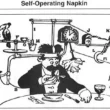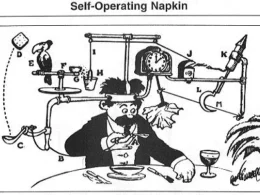Well, predictably enough: Arturo is back!
As our regular readers will recall, Arturo Bris, a professor in Switzerland, issued a report last summer claiming that the SEC’s emergency order banning naked short selling of 19 financial stocks had harmed “market efficiency.” He even claimed that the ban had caused the 19 stocks to lose value relative to the rest of the market.
Professor Arturo plainly fudged his numbers. For example, throughout his report, he calculated percent differences using subtraction instead of division — (X-Y) instead of (X-Y)/X.
Really, his errors were that elementary.
I recalculated Professor Arturo’s raw data, using mathematics instead of a magic hat, and it showed quite the opposite of what he had claimed. The emergency order improved the performance of the 19 affected stocks and had no discernible effect on “market efficiency.”
By then, however, it was too late. The financial media and the short seller lobby had glommed on to Professor Arturo’s report as evidence that the emergency order was a grave mistake. Caving into this pressure, the SEC let the order expire without further adieu. The naked short sellers were given free reign.
You know what happened next – and it wasn’t “market efficiency.”
As for those 19 stocks – including Lehman Brothers (vaporized), Goldman Sachs (nearly vaporized); Morgan Stanley (nearly vaporized); Fannie Mae (nationalized); Freddie Mac (nationalized); and Merrill Lynch (cannibalized) – you could say their “performance” wasn’t so hot. On September 18, the SEC freaked out and banned all short-selling in 800-plus stocks.
Banning legitimate short-selling was a bad idea. But soon, this ban will be lifted, and then we’ll be back to square zero – with illegitimate naked short sellers once again threatening to crater the financial system. To prevent this from happening, the media should be clamoring for the SEC to enforce a permanent, market-wide ban on naked short selling – forcing hedge funds to borrow real stock before they sell it.
Instead, The Wall Street Journal has once again trotted out Professor Arturo to regale readers with more of his mutterings about “market efficiency.” In a Journal op-ed today, the Professor makes the same sort of sweeping claims that he made last summer, though this time he has wisely avoided publishing his raw data, so it is hard to know whether he is once again botching the math.
In any case, I will address each of his points.
PROFESSOR ARTURO POINT NO. 1: “Short selling activity was not excessively high for the 799 stocks from January to the ban’s start. While the percentage of short sales to total shares outstanding hit 19.1% in March, that percentage fell to 14.8% in July, when the sector’s stock prices experienced the greatest drops since March 2007. From Sept. 1 to Sept. 12, short sales in the 799 stocks amounted to a low 6% of shares outstanding. Short sales in relation to trading volume display the same pattern.”
So what? The question is not whether short-selling increased or decreased. It is whether specific criminal hedge funds manipulated the prices of specific stocks. Of those 799 stocks, more than 50 appear on the SEC’s “threshold” list of companies experiencing excessive “failures to deliver” – pretty good evidence of illegal manipulative naked short selling.
Meanwhile, it is important to note that many companies that do not appear on the “threshold” list might nonetheless have been victimized by market manipulators The SEC’s data is incomplete and does not register much illegal naked short selling – such as that which takes place “ex-clearing.” Moreover, a company makes the “threshold list” only if excessive “failures to deliver” occur for five consecutive days.
In the cases of many big financial institutions, the data through June shows unbridled naked short selling (with “failures to deliver” often exceeding 1 million shares) in stretches of less than five days. Typically, these stretches are followed by a brief pause (keeping the stock off the threshold list), after which there is another round of unbridled naked short selling.
The SEC has ordered a couple dozen hedge funds to hand over records of their trading in American International Group, Merrill Lynch, Washington Mutual, Goldman Sachs, Lehman Brothers, and Morgan Stanley. It is not difficult to see why the SEC is investigating. Though only Washington Mutual has appeared on the threshold list, the data through June shows that each of these stocks were exposed to repeated stretches of massive “failures to deliver,” often coinciding with the circulation of false rumors. No doubt, the data through September (soon to be made public) will be even uglier.
PROFESSOR ARTURO POINT NO. 2: “Short-selling activity typically picked up after a stock fell in price, not generally before. Increases in short selling of individual stocks more often occurred the day after a sharp price drop, not before. This is consistent with research conducted by Karl Diether and Ingrid Werner of Ohio State University, and Kuan-Hui Lee of Rutgers, showing that short sellers trade in response to past negative news, and that they reveal information about forthcoming price drops. They may also want to protect their long positions from further declines by locking in prices through short sales… A detailed look at the short-selling transactions on Sept. 9, 2008 — the day Lehman Brothers fell 45% — shows that short sales were much more frequent during the second part of the day, after Lehman shares had already fallen 30%.”
Again, so what? I have no doubt that most short-selling occurs after prices start to drop. Most short selling is legitimate. What should concern The Wall Street Journal is the vast amount of illegitimate naked short selling that is occurring just before hedge funds leak distorted information and false rumors to The Wall Street Journal.
For example, one day last June, somebody naked shorted, and ultimately failed to deliver more than 1 million shares of Lehman Brothers – just before the world was treated to the false rumor that Lehman had gone to the Fed for a bailout.
PROFESSOR ARTURO POINT NO. 3: “Prior to the ban’s start, spreads, liquidity and other metrics for the financial services sector roughly matched the entire market’s norms.”
Yes, “prior to the [current] ban’s start” – namely, during the July to August period when the SEC banned naked short selling of 19 financial stocks – spreads, liquidity and other metrics did, indeed, “roughly match the market’s norms.” In other words, banning naked short selling did no harm whatsoever to the markets. Professor Arturo’s raw data showed this, though he suggested to the press that the opposite was true.
PROFESSOR ARTURO POINT NO. 4: “After the [total ban on short selling] took effect last week, we saw a dramatic shift for the worse (market quality and stock liquidity declined) as investors found it increasingly difficult to hedge market risks. Liquidity dried up.”
In August, Professor Arturo similarly claimed that “liquidity” had dried up after the SEC banned naked short selling in 19 financial stocks. However, his raw data showed precisely the opposite.
This time, he provides no raw data, so who knows if liquidity dried up? In any case, the total ban on short-selling will be lifted, so there is little sense in arguing against it. The question, again, is whether naked short selling has been used to manipulate stocks, and whether the SEC is going to do anything about it.
PROFESSOR ARTURO POINT NO. 5: Bid-ask spreads increased more for the 799 stocks than for the market overall. Comparing the period Jan. 1, 2008, through the ban’s first week shows that relative spreads (that is, the bid-ask spread relative to the quote mid-point) increased from 3.38% to 5.33%. This increase is not due to the financial crisis itself, as relative spreads have also increased from the beginning of September to the past week (from 3.87% to 5.33%).”
I cannot believe this gobbledygook was allowed to appear in the Wall Street Journal. So, from a randomly selected date in January, through a day one week after the short selling ban took affect, spreads increased. From the beginning of September (whenever that was) to “the past week” (whenever that was) spreads increased by precisely the same amount.
What does this mean? Nothing. The question is whether spreads increased during the period of the ban, which went into affect on September 18 — not “at the beginning of September.”
More importantly, since nobody is suggesting that the total ban on short selling will remain in effect, the question is whether spreads increased by some catastrophic amount during the period when the SEC banned naked short selling (temporarily preventing the market from collapsing by a catastrophic amount). In his earlier report, Professor Arturo wrote that “spreads increased” during the ban on naked short selling. However, his raw data showed that spreads on the 19 affected stocks increased by more than any other stocks..
PROFESSOR ARTURO POINT NO. 6: “The intra-day trading range has almost doubled for the 799 stocks over the past week. This means that liquidity deteriorated. Less liquidity makes it more difficult for investors to trade without a severe market impact, and prices are less transparent.”
In his last report, Professor Arturo cited “trading range” as a measure of volatility, not liquidity. As a measure of liquidity, he cited “increased spreads” (which, I have noted, did not, in fact, increase). I suppose it is a matter of convenience for him to now use trading range numbers to support his theory about liquidity (which did not worsen during the more important ban on naked short selling).
PROFESSOR ARTURO POINT NO. 7: “By last Friday, share prices for the 799 stocks did rise 0.11% relative to the market and adjusted for risk. However, such an increase is not statistically significant. The 799 stocks had performed much better in the two previous weeks: Between Sept. 1 and Sept. 19, they outperformed the market on a risk-adjusted basis by 6%. To be sure, one has to believe that much of this movement was attributed to the likelihood of some type of bailout package being passed.”
Financial stocks outperformed the market from Sept 1. to Sept. 19? Tell that to Lehman Brothers, Morgan Stanley, Goldman Sachs, American International Group, Washington Mutual, Merrill Lynch, Bank of America, etc., etc.
Were these stocks manipulated? Why is the Journal not asking that question?
PROFESSOR ARTURO POINT NO. 8: As a result of the ban on short selling, stocks “reacted sluggishly to news. The 799 shares reacted more slowly to news than stocks outside the ban’s umbrella — a key sign of market inefficiency. In an efficient market, individual stocks should be affected primarily by company-specific news rather than overall market activity.”
Professor Arturo made a similar claim about the stocks affected by the July-August ban on naked short selling. His raw data, however, showed precisely the opposite to be the case. During the ban on naked short selling, the affected stocks reacted to news faster than before.
In the absence of any raw data to support this latest claim, I am not inclined to believe it.
PROFESSOR ARTURO POINT NO. 9: In recent weeks, “Investors had difficulty getting pricing for stocks. Trading was down, stock-borrowing costs had soared, and uncertainty hung over the market due to the bailout’s fate and the SEC’s increase of stocks the ban originally covered. The balance of buying and selling that is so critical for markets to function was effectively gone.”
In other words, the market went haywire. That is hardly news. The news (though you don’t read it in The Wall Street Journal) is that this mess could have been prevented if the SEC had expanded its emergency order banning the naked short selling that was quite demonstrably destroying our markets.









Prof ‘Bris’ clearly should go back to his day job of circumcision.
“Bris” is the most naive, captive source that the WSJ has ever found. I wonder which anonymous ATM card he got!
Are they really going to make publicly available short positions of the hedge funds in 2 weeks? I don’t believe it will happen but if so and the information is accurate this could be a major step toward a little more transperancy. http://www.reuters.com/article/hedgeFundsNews/idUSLNE48S01N20080929
Why don’t they make the short positions available now? Now would be better.
They had to give their “friends” enough time to cleanse and rearrange their books as best possible.
There ought to be a law . . . but fear not, their tracks are etched in digital history.
As for point 9, According to the Yahoo Chart, over 100M shares of DJIA stock traded on 9/29.
Trading has been at record levels this year and increased after the short ban.
I dropped a blog post claiming that if anything, the market is currently suffering from hyperactivity and not inefficiency.
http://blog.yintercept.com/2008/09/market-hyperactivity.html
These record trading days are on lack of knowledge and not news.
Professor Arturo Point No. 6: “The intra-day trading range has almost doubled for the 799 stocks over the past week.”
And not just the 799 stocks.
To my mind, with the spotlight being shone on the FTD problem, this means that the naked shortselling problem has morphed into one of predatory INTRA-DAY shortselling. Since positions are “netted out” at the end of the day, if short positions are covered by day’s end, no locate or borrow is needed — and no delivery is needed in three days. All it takes is wink and nod agreements between one’s best-customer hedge funds and their friendly prime brokers.
Firm borrows must be required on ALL short sales — intraday and including options MMs.
http://papers.ssrn.com/sol3/papers.cfm?abstract_id=1140694
Do Short Sellers Front-Run Insider Sales?
Mozaffar Khan
MIT Sloan School of Management
Hai Lu
University of Toronto – Joseph L. Rotman School of Management
June 3, 2008
MIT Sloan Research Paper No. 4706-08
Abstract:
We find evidence of significant increases in short sales immediately prior to large insider sales, consistent with information leakage and front-running. We examine a number of alternative explanations that the increase in short sales is driven by public information about the firm or about the impending insider sale, but the evidence is inconsistent with these explanations. The result has implications for the enforcement of insider information regulations, and for timely disclosure of short sales information by stock exchanges.
Keywords: Short Selling, Insider Sales, Front Running, Information Leakage
JEL Classifications: G10, G14, G18, G30, M41
Working Paper Series
Prof. Bris has direct ties to Yale University.
James Chanos has direct ties to Yale University.
Prof. Bris was nobody until he came out on his report regarding the mandatory pre-borrow Emergency Order in July. The WSJ and NY Times picked up his comments and ran with it – now he is suddenly a somebody.
The WSJ has published 3 opinion letters on short selling in the past months – such letters were originated by Prof. Bris and James Chanos. All letters have the exact same underlying rationalizations and conclusions. The NY Times ran all opinion letters through their blog.
Are we seeing a pattern here? If Bris is this short sale expert, where has he been these past few years? We certainly never heard his name amongst all those economists that were spouting opinion on teh short sale issues. Is it coincidence that Yale lost Chanos mouthpiece Owen Lamont to a short sale hedge fund and suddenly a new Yale pundit appears in Prof. Bris?
We Are Under Martial Law! As Declared By The Speaker Last Night! Rep Burgess
http://www.youtube.com/watch?v=l7B4laX1E70
George Bush also has ties to Yale……just pointing that out.
On another note, where can I find the fail to deliver list?
And how come no one is pointing out the fact that investment banks running at 30 to 1 leverage is a bad business model and a small hit on their capital is very bad for their leverage/asset base.
Here is a link to where the SEC publishes the CNS fails to deliver.
http://sec.gov/foia/docs/failsdata.htm
I did some research on Professor Bris and have found many flaws in his analysis. The foundation of his flaws, his studies are all based on prior studies conducted by economists evaluating short selling in the 60, 70, 80’s, etc…Clearly program trading, hedge funds, decimalization, and derivative market growth make those studies invalid to todays trading style and impacts. Likewise, all the studies he used as his research came from people of common opinion.
Bris wrote “Giving pessimists and optimists equal opportunities to commit their capital engenders competition that enhances price discovery.” And while writing this, Bris went out and research short selling from the vantage point of short sale apoligists within his profession. All of his studies center around people of common thought. Doesn’t that make him a hypocrite as it relates to short sale analysis. If price discovery requires views of optimist and pessimist, how can short sale analysis be efficient if all the views being evaluated, and all the data evaluated, is being done by economists in the exact same way.
Why they tried to rush the bailout through.
http://www.rumormillnews.com/cgi-bin/forum.cgi?read=132199
http://www.opednews.com/articles/Naked-Short-Selling-and-Ph-by-Allen-Heart-080929-462.html
Phantom shares are all about fractionally backed securities ownership. Debt and equity securities are treated like a new form of unregulated, fiat money.
http://tinyurl.com/4ssd88
It appears to me that the markets are rigged. All games that can be rigged will be rigged, sooner or later. The Fed, working in league with the U.S. Government, rigs the U.S. markets. But don’t think for a second that the Fed has some kind of monopoly on a situation where rapacity pervades honest reason. All markets are rigged. Central bankers, the world over, are primarily involved in fleecing the people. The fact that the Fed is the most powerful of the Central Bankers, and that they are primarily responsible for perfecting the insidious contrivance called inflation, has not kept the rest of Central Bankers of the world from entering into a game of “catch up”. As far as they are concerned, there is only one motive, and that motive is economic world domination. Which Central Bankers will dominate will depend on which ones end up with the most. That’s just the nature of absolute corruption. That is the reason that whole world is currently strapped with a fiat system. The ability to create money, out of thin air, provides for absolute economic power. Absolute power equals absolute corruption. It’s as simple as that. By rigging the markets, through various forms of intervention, the central bankers have set up a scheme whereby the wealth of the world could be siphoned off at will.
Ahh yes, there is the about face i knew was coming. Sorry to get your hopes up. Never mind all that talk about transperancy.
http://www.marketwatch.com/news/story/sec-backs-down-short-selling-disclosure/story.aspx?guid={1FC46375-2DBA-4C7B-964E-B9D95F78C416}&dist=msr_11
Late Wednesday, the regulator said that institutional investors’ short positions won’t be made public, a major change from an earlier ruling that had upset several prominent hedge-fund managers and short sellers including James Chanos.
“…to put an end to criminal activity that has eviscerated hundreds of companies and destroyed countless lives…”
..sorry for being a little out of context, but i think the last statement is overrated, especially if the writer is only referring to the US context…you should see firsthand the impact of the 1997 crisis on the poor in Asian countries…THAT is what “destroyed lives” looks like…